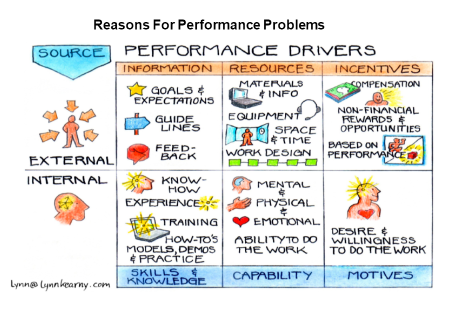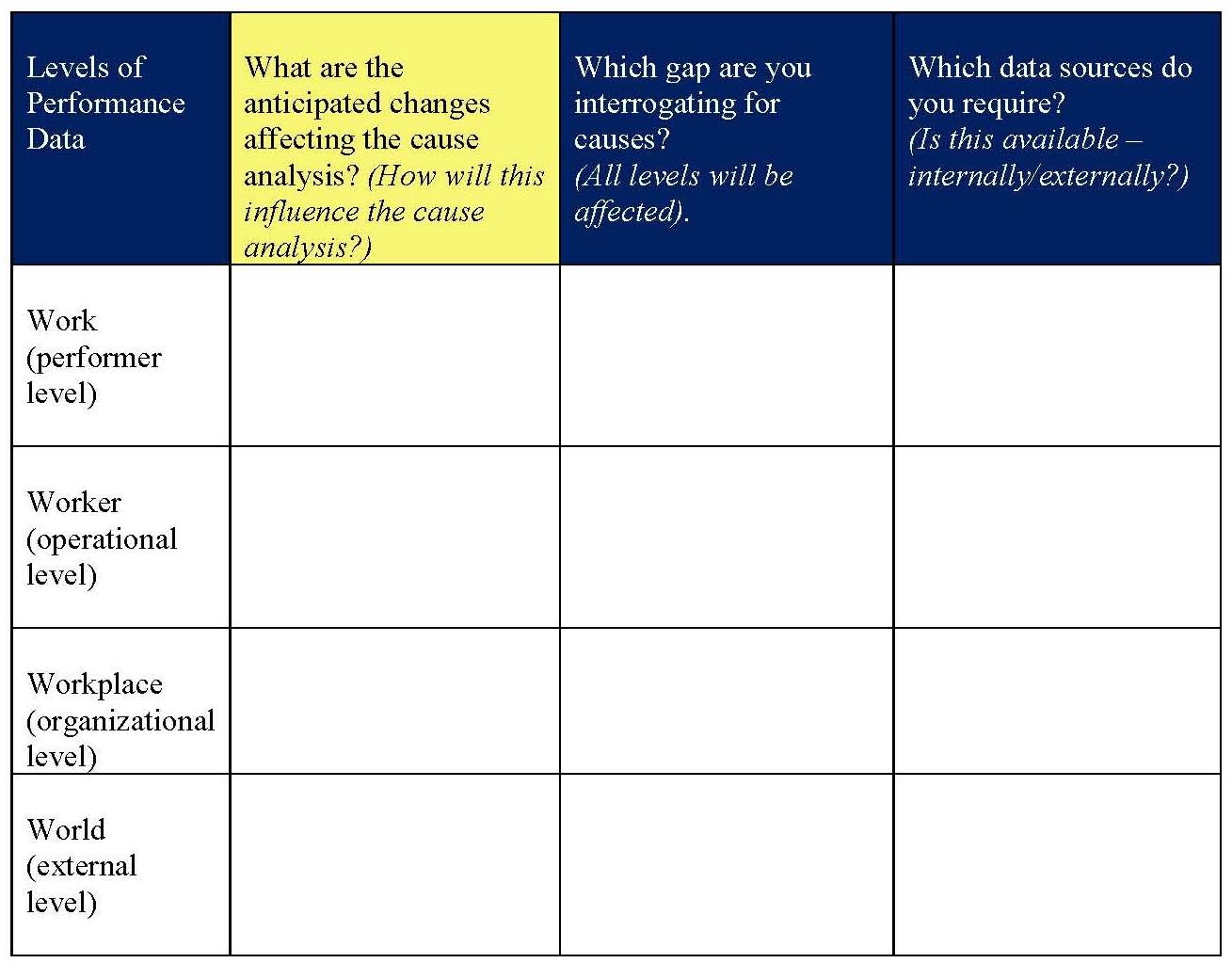For more information about Improvid Performance Consulting visit our Human Performance Improvement website.
Part 4 of a series of articles on the 10 Standards for Performance Improvement.
In today’s disruptive business environment, it is important to be flexible when change is about to happen and ensure what the impact will be on continuous performance improvement.
The most important part of our work is finding the relevant data and facts. Irrelevant data is just that—irrelevant. Yet, while the volume of available data has grown exponentially in recent years, most companies are only using a fraction of that data in determining causes of performance problems.
Acquiring the skills needed to derive insights from data is a key skill set managers and performance consultants should have. It requires getting the right data insights into the hands of decision makers – and making sure the cause analysis is derived from these data-driven insights.
In a series of articles, I will focus on the 10 Standards for Performance Improvement. You can find a full explanation of these standards at www.ispi.org.
As a recap of what we said in the previous articles, the first four standards are known as principles because they are the lenses through which we will apply systematic methodology of consulting and managing. Our methodology guides us to how we do it. In part 3 of our series, we started the consulting process by asking and answering “where is the gap?” In this article, I will focus on the sixth standard.
STANDARD 6: DETERMINE CAUSE
Competent practitioners and managers design a plan to find out why a gap exist once we know where it exists. This is in line with focusing on what the end-result is we need to achieve. In other words, we keep the focus on how to possibly improve the performance, change job behaviour or adopt a new strategy. We look for the underlying causes to achieve this. In focusing on the end result, we will apply our differentiating holistic approach. Our work as managers and performance consultants is identifying underlying causes to performance issues at a workplace level (organisational impact), work level (operational impact) and worker level (people impact). What informs our approach is the world level (external impact) which we usually have no control over.
How is it done?
- Choose the appropriate method of analysis
- Decide on how to best get the data
- Gather the data
- Analyse the data
- Determine the underlying causes
- Report the interim and final findings with recommendations
- Facilitate discussions with clients to understand the contributing causes
- Interpret the findings for the project owner
Practical framework:
Below is a framework (Figure 1) to use in a cause analysis based on the work of Thomas Gilbert’s behavior engineering model. Gilbert only considered the workplace and the worker levels. In our holistic consulting approach, we also consider the work and world levels.

Figure 1: Reasons for performance problems.
Published courtesy of Lynn Kearney (lynn@lynnkearny.com).
Below is an example of a framework to plan the data sources required for a cause analysis:

Figure 2: Practical data sourcing map.
Practical guidelines:
Here are some consulting tips to determine the causes:
- Do not jump to conclusions or solutions during the cause analysis.
- Plan your cause analysis and stick to it.
- Do not abandon you cause analysis when you feel overwhelmed with your findings.
- Get buy-in and commitment from champions and decision makers for your cause analysis activities.
- Answer all questions about your activities openly and honestly – many people at various levels can be anxious about your findings.
- Communicate immediate findings with empathy and transparency immediate findings – this may assist to plan for “quick wins.”
- Do not start analysing causes that have not been identified during gap analysis.
- Be transparent when you are doing cause analysis – management and other role players may be sensitive to your investigations.
- Do not let others derail your cause analysis plans – keep your focus intact.
- Be flexible 0 environments and external factors out of your control can impact and influence a change in direction.
- Be prepared for disruptive technology and automation that may slow down your cause analysis.
- Be mindful of all other projects happening in your or your client’s organisation.
- Do not go after the familiar paths for your analysis – sometimes the real reasons and causes are hidden.
- Focus on being authentic and building credibility – this will make your work less “suspicious.”
Checklist:
Use the checklist tool to stay on track with your cause analysis:
- Do you have a data source map?
- Do you have analysis skills?
- Are you considering the culture and environment of the industry?
- Have you identified the analysis methods appropriate to the gaps you want to interrogate?
- Are you carrying out the cause analysis at the appropriate level: individual, group, process, organisational, or societal levels?
- Have you shared recommendations on the immediate interim findings?
- Are you correctly using documents and work outputs as a source of data?
- Have you identified the physical and technological opportunities and constraints in the work environment?
- Have you identified the actual and expected outputs of your cause analysis?
- Have you identified which systems are outdated for conducting your cause analysis?
- Do you have to design and develop systems because they do not exist to complete a cause analysis?
- Have you determined the feasibility of doing a cause analysis on a particular gap?
Useful websites, articles and blog links:
Below is additional useful information for your own development.
- http://www.prime2.org/sst/stage6.html
- http://ti4wp.com/
- https://improvid.co.za/site/
- http://www.sixboxes.com/
- www.improvidblog.com
- Performance Architecture, R. Addison et al
- Serious Performance Consulting, R. Rummler
- Root Cause Analysis – Mini Guidebook
Conclusion
In conclusion, taking into consideration the speed at which the world of work is changing, managers and performance consultants should be mindful of the correct applicable data sources when doing a cause analysis. There is no one tool that will determine the cause. You need to decide and customise the methods and tools to fit your industry culture – these will prove useful in the long run. The quality of a cause analysis will determine the success of the sustainability of the results you want to change.
Over the next 12 months, I will be publishing a series of articles that will focus in-depth on the 10 International Standards of ISPI. Each article will focus specifically on tips, tools, and links to articles, websites, and more. Stay posted!
If you would like to know more about what we do, please visit our website www.improvid.co.za or connect with Belia Nel on LinkedIn.

